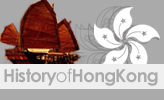| Date | Governor | Events | Other people/events |
|---|
| 1841 | Charles Elliot | Convention of Chuenpi
Commodore Gordon Bremer at Possession Point | |
| 1842 | Henry Pottinger | Treaty of Nanjing | |
| 1843 | | Formation of the Legislative Council and Executive Council | Ying Wa College, world's first Anglo-Chinese school relocated to Hong Kong |
| 1844 | | | |
| 1847 | John Francis Davis | Building of Kowloon Walled city | |
| 1848 | | | |
| 1851 | George Bonham | | Taiping Rebellion |
| 1853 | | Chinese serial | |
| 1854 | | | |
| 1855 | John Bowring | First proposal of Praya Reclamation Scheme
Battle of Ty-ho Bay | |
| 1856 | | Second Opium War | |
| 1859 | Hercules Robinson | | |
| 1860 | | Convention of Peking,
British rules Kowloon south of Boundary Street,
Establishment of Diocesan Girls' School | |
| 1861 | | British acquired Kowloon Peninsula | Frederick Stewart modernise HK education |
| 1865 | | Establishment of HK Shanghai Bank | |
| 1866 | Richard Graves
MacDonnell | Four big families of Hong Kong (est.) | |
| 1868 | | The Viceroy of Guangdong and Guangxi, ordered four customs stations to be established in waterways surrounding Hong Kong and Kowloon at Fat Tong Chau, Ma Wan, Cheung Chau and Kowloon Walled City. It was so-called "blockade of Hong Kong" by the Hong Kong Government. [2] These stations ceased to operate in 1899 after the lease of the New Territories to Britain. [3] | |
| 1872 | | Tung Wah Hospital established | |
| 1874 | Arthur Kennedy | 1874 Hong Kong Typhoon | Founding of the Universal Circulating Herald |
| 1877 | Arthur Kennedy | | |
| 1882 | John Pope Hennessy | | |
| 1883 | George Bowen | | |
| 1887 | William Des Vœux | Western medical science reaches Hong Kong College of Medicine for Chinese | |
| 1888 | | Founding of Peak Tram | |
| 1891 | William Robinson | | |
| 1894 | | Third Pandemic of Bubonic Plague | |
| 1898 | | Second Convention of Peking,
British rules New Territories and New Kowloon | |
| 1899 | | Six-Day War | |
| 1904 | Henry Arthur Blake | Peak Reservation Ordinance | |
| 1906 | | 1906 Hong Kong typhoon | |
| 1907 | Matthew Nathan | | |
| 1908 | | 1908 Hong Kong Typhoon | |
| 1910 | | Opening of Kowloon–Canton Railway | |
| 1912 | Frederick Lugard | | Establishment of the Republic of China,
Qing dynasty overthrown | |
| 1918 | | Happy Valley Racecourse fire
Gresson Street shootout | |
| 1919 | Francis Henry May | | |
| 1921 | | Praya East Reclamation Scheme | |
| 1922 | | Seamen's strike of 1922 | |
| 1923 | Reginald Edward Stubbs | Sun Yat-sen proclaimed his anti-corruption revolutionary ideas came from Hong Kong during HK university speech | |
| 1924 | | Land allocation for Kai Tak Airport | |
| 1925 | | Canton-Hong Kong strike | |
| 1926 | Cecil Clementi | First Chinese member appointed to Executive Council | |
| 1928 | | First pre-RTHK radio broadcast | |
| 1930 | William Peel | | |
| 1933 | | Founding of Kowloon Motor Bus | |
| 1935 | Andrew Caldecott | | |
| 1937 | | Great Hong Kong Typhoon of 1937 | |

